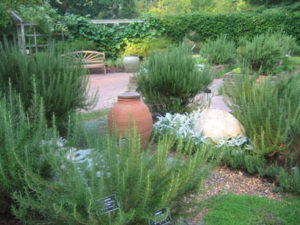Herbs are a wonderful way to connect to the outdoors. Whether you live in the city or suburbia, an herb garden is attainable. All you need is the appropriate soil and plenty of sun.
A perfect location for an herb garden is in a sunny location near your kitchen door so that you can step out and harvest some fresh herbs when preparing a meal. I often get dinner started and snip some herbs while the food is cooking. If you do not have a sunny area near your door, other sunny spots will do. And even if you live in an apartment, many herbs can be grown in pots outdoors, or even on a windowsill.
As with all gardens, it is important to give your plants the right conditions, meaning we need to meet their cultural requirements. Since many of our culinary herbs are native to the Mediterranean, they tend to like it hot and dry and require excellent drainage. These herbs include Rosemary, Thyme, Sage, Tarragon, Lavender, Marjoram, and Oregano. For this reason, they should be grouped together in your landscape, instead of intermingled with other plants which have different cultural requirements.
Giving herbs warm temperatures and sunshine is generally not a problem in Pennsylvania, but good drainage can be an issue, especially if you have clay soil. Frequently, herbs seem to do well in the summer, and even make it through the winter, only to die the following spring. This is often due to saturated soils. For this reason, the soil in herb gardens may need to be amended. Adding compost improves drainage, loosens soils, and incorporates organic matter. In extremely heavy soils, sand may also be used. Mediterranean soils also tend to be limestone based, whereas ours are more acidic, so lime may need to be added. Soil tests will tell you the pH of your soil.
Once you determine the location and prepare the soil, it is time to plant. Select a variety of plants to increase the appeal and usefulness of your garden. I like to arrange herbs so that plants with silver foliage, such as Lavenders, Sage, or Silver Thyme are planted next to darker herbs like Rosemary and Germander. This will provide visual interest along with variety. Flower color is often a secondary consideration in an herb garden, but since many herbs have blue flowers, adding pink Thymes, and yellow Santolinas can add visual appeal.
After your herb garden is planted, remember not to overwater. Watering should be done immediately after planting, and if you see any signs of wilt. Other than that, water sparingly. Also, do not over fertilize. Mediterranean herbs generally like low fertility and too much fertilizer causes plants to be lanky and lack flavor.
Now that your herb garden is installed, it is time to enjoy. Do not be intimidated about cooking with fresh herbs. One very simple way to use them is to sauté a handful of herbs in olive oil with a chopped shallot, and brush on boneless chicken breasts while grilling. You can use any one of your culinary herbs or combine several. I especially like grilled Tarragon chicken in the summer. Served with rice, sliced tomato, and cucumber, it is a perfect summertime meal.
For more recipes utilizing fresh herbs, visit our Pinterest board or share your favorites on our Facebook page.



